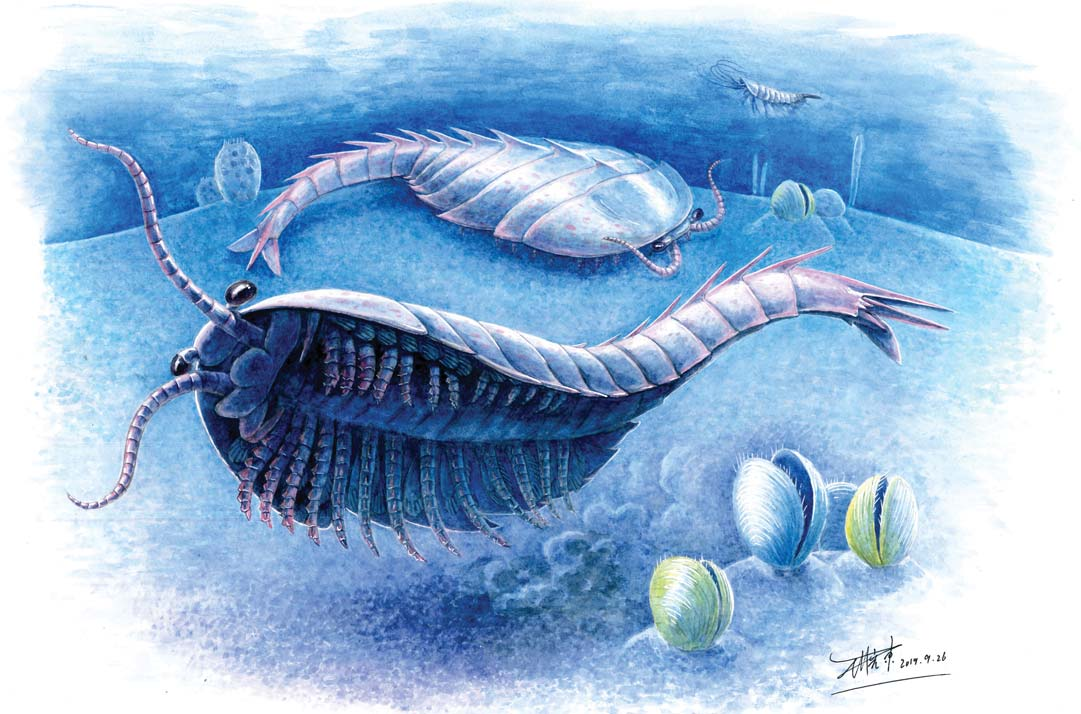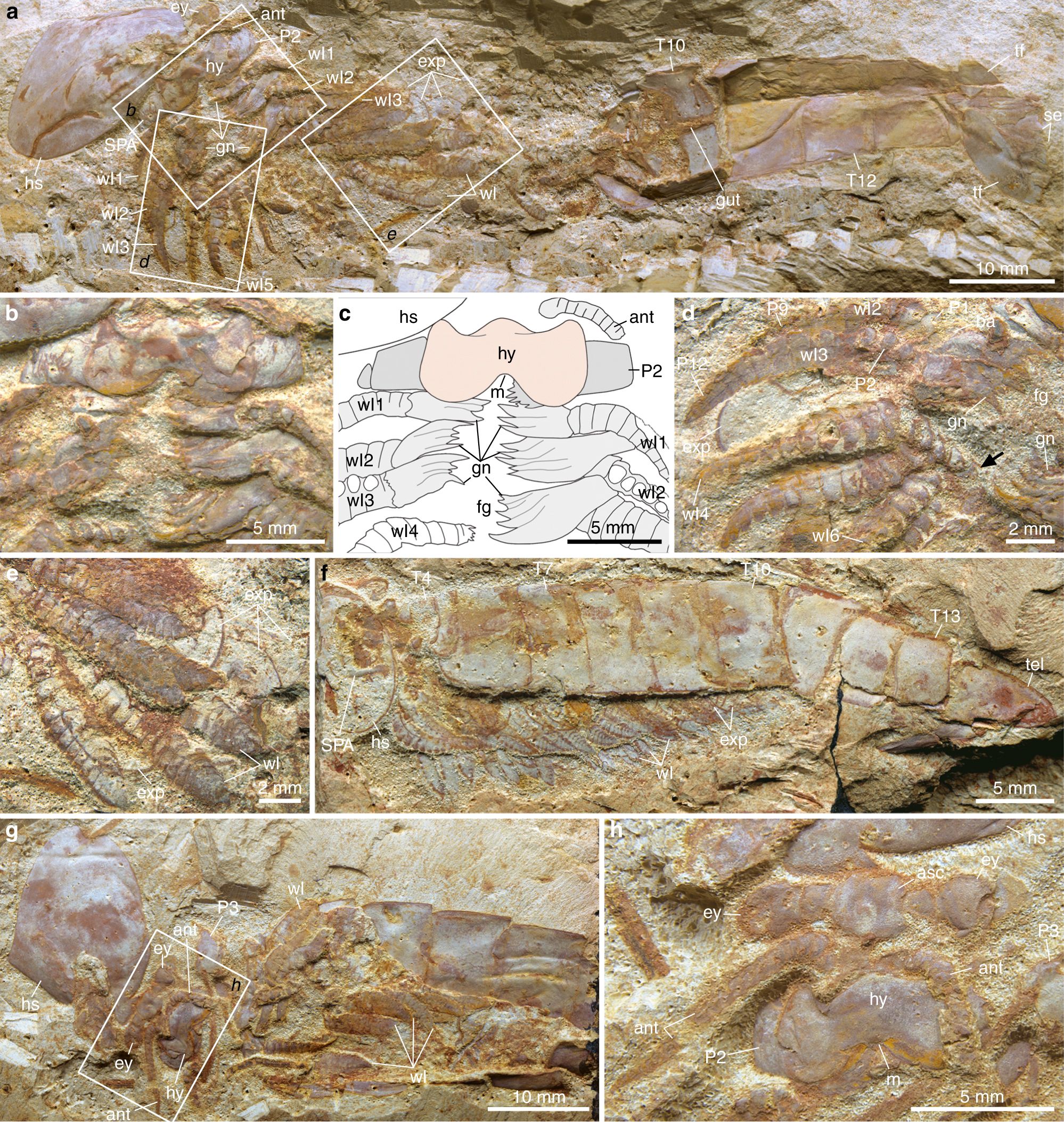|
Guangweicaris
''Guangweicaris'' is an extinct genus of fuxianhuiid arthropod known from the Cambrian period. It is only known from the type species ''Guangweicaris spinatus'', which is known from the Cambrian Stage 4 Guanshan Biota near Kunming. It is currently the latest known fuxianhuiid. It was first described in 2007, and was given a comprehensive re-description in 2020. It is currently known from over 150 specimens. Within the fuxianhuiids it is sister to ''Fuxianhuia'', together forming the clade Fuxianhuiidae. In comparison to ''Fuxianhuia'' it has a wide, oval shaped opisthothorax and a proportionally longer, narrow tail-like abdomen, with 3 prothoracic tergites A ''tergum'' (Latin for "the back"; plural ''terga'', associated adjective tergal) is the dorsal ('upper') portion of an arthropod segment other than the head. The anterior edge is called the 'base' and posterior edge is called the 'apex' or 'mar ..., 5 opisthothoracic tergites and 7 abdominal tergites, it also possesses a ro ... [...More Info...] [...Related Items...] OR: [Wikipedia] [Google] [Baidu] |
Guangweicaris Restoration
''Guangweicaris'' is an extinct genus of fuxianhuiid arthropod known from the Cambrian period. It is only known from the type species ''Guangweicaris spinatus'', which is known from the Cambrian Stage 4 Guanshan Biota near Kunming. It is currently the latest known fuxianhuiid. It was first described in 2007, and was given a comprehensive re-description in 2020. It is currently known from over 150 specimens. Within the fuxianhuiids it is sister to ''Fuxianhuia ''Fuxianhuia'' is a genus of Lower Cambrian fossil arthropod known from the Chengjiang fauna in China. Its purportedly primitive features have led to its playing a pivotal role in discussions about the euarthropod stem group. Nevertheless, despit ...'', together forming the clade Fuxianhuiidae. In comparison to ''Fuxianhuia'' it has a wide, oval shaped opisthothorax and a proportionally longer, narrow tail-like abdomen, with 3 prothoracic tergites, 5 opisthothoracic tergites and 7 abdominal tergites, it also possesses a r ... [...More Info...] [...Related Items...] OR: [Wikipedia] [Google] [Baidu] |
Guangweicaris Fossil1
''Guangweicaris'' is an extinct genus of fuxianhuiid arthropod known from the Cambrian period. It is only known from the type species ''Guangweicaris spinatus'', which is known from the Cambrian Stage 4 Guanshan Biota near Kunming. It is currently the latest known fuxianhuiid. It was first described in 2007, and was given a comprehensive re-description in 2020. It is currently known from over 150 specimens. Within the fuxianhuiids it is sister to ''Fuxianhuia ''Fuxianhuia'' is a genus of Lower Cambrian fossil arthropod known from the Chengjiang fauna in China. Its purportedly primitive features have led to its playing a pivotal role in discussions about the euarthropod stem group. Nevertheless, despit ...'', together forming the clade Fuxianhuiidae. In comparison to ''Fuxianhuia'' it has a wide, oval shaped opisthothorax and a proportionally longer, narrow tail-like abdomen, with 3 prothoracic tergites, 5 opisthothoracic tergites and 7 abdominal tergites, it also possesses a r ... [...More Info...] [...Related Items...] OR: [Wikipedia] [Google] [Baidu] |
Fuxianhuiida
Fuxianhuiida is an extinct clade of arthropods from the Cambrian of China. All currently known species are from Cambrian Series 2 aged deposits in Yunnan Province, including the Chengjiang biota. They are generally considered to be close to the base of Euarthropoda, but have also been considered to be early mandibulates. Many specimens are known with exceptional soft tissue preservation, including preserved guts and neural tissue, which given their basal phylogenetic position makes them important in understanding the evolution of arthropoda as a whole. They reach a size of up to 15 cm, and are interpreted as benthic predators and scavengers. The fuxianhuiid exoskeleton is unmineralised, and the number of tergites ranges from 15 to over 40. The cephalon is covered by a head shield and contains stalked eyes connected by the anterior sclerite, antennae, a butterfly shaped hyposome and a posterior facing mouth. Fuxianhuiids possess specialized post-antennal appendages with se ... [...More Info...] [...Related Items...] OR: [Wikipedia] [Google] [Baidu] |
Fuxianhuia
''Fuxianhuia'' is a genus of Lower Cambrian fossil arthropod known from the Chengjiang fauna in China. Its purportedly primitive features have led to its playing a pivotal role in discussions about the euarthropod stem group. Nevertheless, despite being known from many specimens, disputes about its morphology, in particular its head appendages, have made it one of the most controversial of the Chengjiang taxa, and it has been discussed extensively in the context of the arthropod head problem. The genus is named after Fuxian Lake (''Fuxian Hu''), where it was unearthed. Its specific name (zoology), specific name ''wikt:protensus, protensa'' refers to its extended trunk. Description Complete ''Fuxianhuia'' specimens are approximately 4 centimetres long. The anterior of ''Fuxianhuia'' is encased in an oval sclerite, from which two stalked eyes emerge. Inserting directly behind this sclerite, on the head shield proper, are two stout antennae. When the head of ''Fuxianhuia'' wa ... [...More Info...] [...Related Items...] OR: [Wikipedia] [Google] [Baidu] |
Alacaris
''Alacaris'' is an extinct genus of fuxianhuiid arthropod known from the Cambrian period. It is only known from the type species ''Alacaris mirabilis'' (mistakenly named ''Alacaris multinoda'' in a figure in the describing paper) from the Cambrian Stage 3 aged Xiaoshiba Lagerstätte in Yunnan Province, China. It is morphologically similar to '' Chengjiangocaris'', with which it forms a clade within Fuxianhuiida. Individuals reach a maximum of 12 centimetres in length, with a trunk consisting of 13 tergites A ''tergum'' (Latin for "the back"; plural ''terga'', associated adjective tergal) is the dorsal ('upper') portion of an arthropod segment other than the head. The anterior edge is called the 'base' and posterior edge is called the 'apex' or 'mar .... The basal region of the post- deutocerebral limbs were used in feeding, with the rhythmic movement of the legs guiding food towards the mouth along the food groove between the limbs, with gnathobases present near the mouth to m ... [...More Info...] [...Related Items...] OR: [Wikipedia] [Google] [Baidu] |
Chengjiangocaris
''Chengjiangocaris'' is an extinct genus of fuxianhuiid arthropod known from the Cambrian of South China. It contains two species, ''C. longiformis'' which was described in 1991. ''C. kunmingensis'' was described in 2013 by Javier Ortega-Hernández and colleagues. One specimen of ''C. kunmingensis'' shows detailed evidence of a nervous system. Anatomy ''C. kunmingensis'' has 20 anterior trunk tergites and up to 16 narrow anterior tergites. Phylogeny After References Further reading *Jie Yang et al.Fuxianhuiid ventral nerve cord and early nervous system evolution in Panarthropoda - abstract Proceedings of the National Academy of Sciences ''Proceedings of the National Academy of Sciences of the United States of America'' (often abbreviated ''PNAS'' or ''PNAS USA'') is a peer-reviewed multidisciplinary scientific journal. It is the official journal of the National Academy of Sci ..., subscription required for full article *Javier Ortega-HernándezOpinion: Our 500 ... [...More Info...] [...Related Items...] OR: [Wikipedia] [Google] [Baidu] |
Arthropod
Arthropods (, (gen. ποδός)) are invertebrate animals with an exoskeleton, a Segmentation (biology), segmented body, and paired jointed appendages. Arthropods form the phylum Arthropoda. They are distinguished by their jointed limbs and Arthropod cuticle, cuticle made of chitin, often Mineralization (biology), mineralised with calcium carbonate. The arthropod body plan consists of segments, each with a pair of appendages. Arthropods are bilaterally symmetrical and their body possesses an exoskeleton, external skeleton. In order to keep growing, they must go through stages of moulting, a process by which they shed their exoskeleton to reveal a new one. Some species have wings. They are an extremely diverse group, with up to 10 million species. The haemocoel, an arthropod's internal cavity, through which its haemolymph – analogue of blood – circulates, accommodates its interior Organ (anatomy), organs; it has an open circulatory system. Like their exteriors, the internal or ... [...More Info...] [...Related Items...] OR: [Wikipedia] [Google] [Baidu] |
Cambrian
The Cambrian Period ( ; sometimes symbolized C with bar, Ꞓ) was the first geological period of the Paleozoic Era, and of the Phanerozoic Eon. The Cambrian lasted 53.4 million years from the end of the preceding Ediacaran Period 538.8 million years ago (mya) to the beginning of the Ordovician Period mya. Its subdivisions, and its base, are somewhat in flux. The period was established as "Cambrian series" by Adam Sedgwick, who named it after Cambria, the Latin name for 'Cymru' (Wales), where Britain's Cambrian rocks are best exposed. Sedgwick identified the layer as part of his task, along with Roderick Murchison, to subdivide the large "Transition Series", although the two geologists disagreed for a while on the appropriate categorization. The Cambrian is unique in its unusually high proportion of sedimentary deposits, sites of exceptional preservation where "soft" parts of organisms are preserved as well as their more resistant shells. As a result, our understanding of the Ca ... [...More Info...] [...Related Items...] OR: [Wikipedia] [Google] [Baidu] |
Cambrian Stage 4
Cambrian Stage 4 is the still unnamed fourth stage of the Cambrian and the upper stage of Cambrian Series 2. It follows Cambrian Stage 3 and lies below the Wuliuan. The lower boundary has not been formally defined by the International Commission on Stratigraphy. One proposal is the first appearance of two trilobite genera, ''Olenellus'' or '' Redlichia''. Another proposal is the first appearance of the trilobite species '' Arthricocephalus chauveaui''. Both proposals will set the lower boundary close to million years ago. The upper boundary corresponds to the beginning of the Wuliuan. Naming The International Commission on Stratigraphy The International Commission on Stratigraphy (ICS), sometimes referred to unofficially as the "International Stratigraphic Commission", is a daughter or major subcommittee grade scientific daughter organization that concerns itself with stratigr ... has not named the fourth stage of the Cambrian yet. In the widely used Siberian nomenclature stage ... [...More Info...] [...Related Items...] OR: [Wikipedia] [Google] [Baidu] |
Kunming
Kunming (; ), also known as Yunnan-Fu, is the capital and largest city of Yunnan province, China. It is the political, economic, communications and cultural centre of the province as well as the seat of the provincial government. The headquarters of many of Yunnan's large businesses are in Kunming. It was important during World War II as a Chinese military center, American air base, and transport terminus for the Burma Road. In the middle of the Yunnan–Guizhou Plateau, Kunming is at an altitude of above sea level and a latitude just north of the Tropic of Cancer. As of 2020 census, Kunming had a total population of 8,460,088 inhabitants, of whom 5,604,310 lived in its built-up (or metro) area made of all urban districts but Jinning, not conurbated yet. It is at the northern edge of Dian Lake, surrounded by temples and lake-and-limestone hill landscapes. Kunming consists of an old, previously walled city, a modern commercial district, residential zones and university areas. ... [...More Info...] [...Related Items...] OR: [Wikipedia] [Google] [Baidu] |
Tergum
A ''tergum'' (Latin for "the back"; plural ''terga'', associated adjective tergal) is the Anatomical terms of location#Dorsal and ventral, dorsal ('upper') portion of an arthropod segment other than the head. The Anatomical terms of location#Anterior and posterior, anterior edge is called the 'base' and posterior edge is called the 'apex' or 'margin'. A given tergum may be divided into hardened plates or sclerites commonly referred to as tergites. In a Thorax (insect anatomy), thoracic segment, for example, the tergum may be divided into an anterior notum and a posterior Scutellum (insect), scutellum. Lateral extensions of a tergite are known as paranota (Greek for "alongside the back") or ''carinae'' (Latin for "keel"), exemplified by the flat-backed millipedes of the order Polydesmida. Kinorhynchs have tergal and sternal plates too, though seemingly not homologous with those of arthropods. Tergo-tergal is a stridulation, stridulatory mechanism in which fine spines of the abdom ... [...More Info...] [...Related Items...] OR: [Wikipedia] [Google] [Baidu] |









